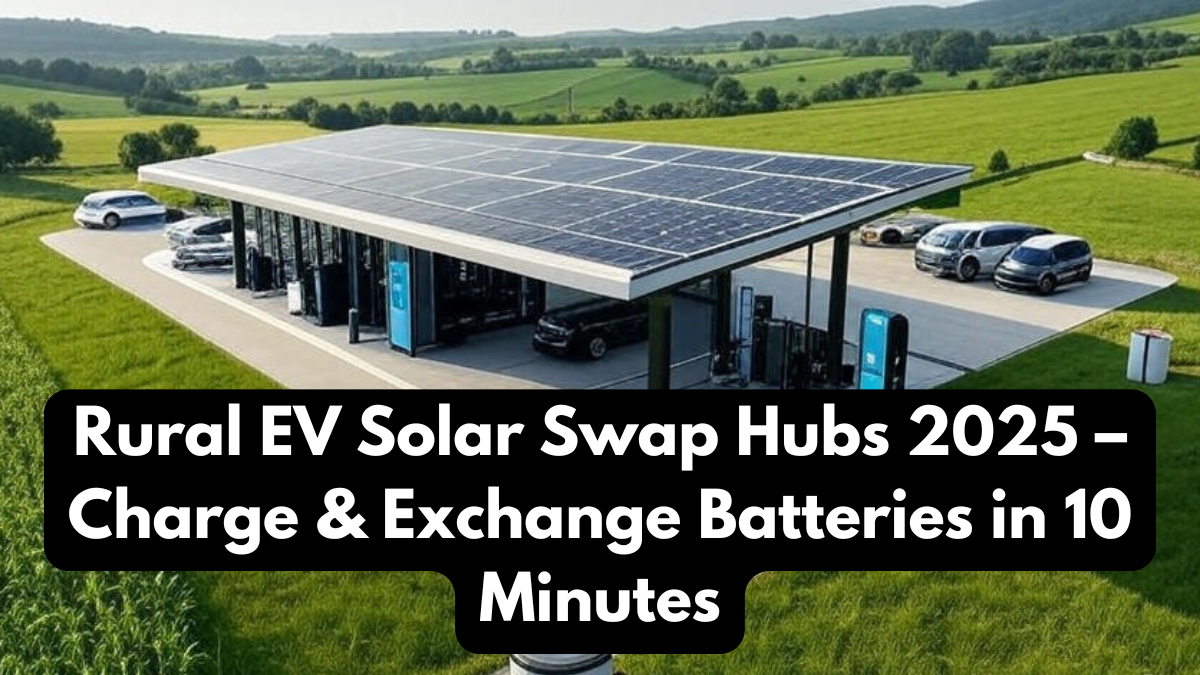India’s shift toward electric mobility is no longer confined to its cities. In 2025, Rural EV Swap Hubs are making it possible for electric vehicles in remote areas to recharge and replace batteries in minutes. Powered by Solar Charging Stations, these hubs are bridging the gap between sustainability and accessibility, ensuring rural communities are not left behind in the EV revolution. Fast, eco-friendly, and community-focused, they are redefining the future of transport in the countryside.

How Rural EV Swap Hubs Work
A Rural EV Swap Hub is a centralized location where drivers can quickly exchange a depleted battery for a fully charged one. The integration of Solar Charging Stations ensures these batteries are powered sustainably, even in regions with unreliable grid access.
Key features include:
- 10-minute battery swap service
- Solar-powered charging systems for continuous operation
- Compatibility with multiple EV models
- Affordable subscription or pay-per-use pricing
This model eliminates “range anxiety” and ensures that electric mobility remains viable in rural regions with long travel distances between towns.
Benefits of Solar Charging Stations in Rural Areas
The use of Solar Charging Stations at Rural EV Swap Hubs offers multiple benefits beyond sustainability. Solar energy reduces operational costs, avoids dependence on unstable rural electricity grids, and supports India’s renewable energy goals.
Here’s a comparison of traditional charging setups versus solar-powered swap hubs:
Feature |
Traditional Charging Station |
Rural EV Swap Hub with Solar Charging Stations |
|---|---|---|
Power Source |
Grid electricity |
Solar energy |
Charging Time |
Several hours |
10 minutes (swap) |
Environmental Impact |
Grid-dependent emissions |
Zero-emission charging |
Suitability for Rural Areas |
Limited by grid access |
Fully self-sustaining |
Driving Economic Growth in Rural Communities
The Rural EV Swap Hubs are more than just an infrastructure upgrade — they’re catalysts for local economic growth. By introducing Solar Charging Stations, these hubs create job opportunities for technicians, operators, and maintenance staff. They also attract new business opportunities, from EV rentals to rural delivery services powered by electric vehicles.
In many areas, farmers are adopting electric two-wheelers and small cargo EVs for transporting goods to markets, benefiting directly from the faster turnaround times of swap hubs.
Future Expansion and Technological Innovations
By 2025, the plan is to establish thousands of Rural EV Swap Hubs across India, each equipped with advanced Solar Charging Stations and AI-based management systems. Future developments include:
- Smart battery tracking for optimal usage
- Predictive maintenance alerts
- Integration with mobile apps for booking and payments
- Partnerships with local cooperatives for community-led management
As technology advances, these hubs will also support larger EVs, including buses and agricultural machinery, further broadening their impact.
Conclusion
The Rural EV Swap Hubs of 2025 are proving that sustainable mobility is possible anywhere. With Solar Charging Stations at their core, they deliver fast, eco-friendly solutions tailored to the unique needs of rural India. By combining innovation with accessibility, these hubs are not only powering vehicles but also empowering communities toward a cleaner, more connected future.
FAQs
What is a Rural EV Swap Hub?
It’s a facility where EV drivers can exchange depleted batteries for charged ones, reducing downtime to just a few minutes.
How do Solar Charging Stations improve these hubs?
Solar Charging Stations provide clean, renewable energy, making the hubs independent from unreliable rural electricity grids.
Are Rural EV Swap Hubs only for cars?
No, they cater to two-wheelers, three-wheelers, and small commercial EVs, with plans to support larger vehicles.
How much does it cost to use a swap hub?
Costs vary, but most hubs offer affordable rates through subscription plans or per-swap fees.
Will these hubs work during cloudy or rainy days?
Yes, battery storage systems ensure power availability even during low sunlight conditions.
Click here to learn more